On May 30…
“These heroes are dead. They died for liberty. They died for us. They are at rest. They sleep in the land they made free, under the flag they rendered stainless, under the solemn pines, the sad hemlocks, the tearful willows, and the embracing vines. They sleep beneath the shadows of the clouds, careless alike of sunshine or of storm, each in the windowless Place of Rest. In the midst of battle, in the roar of conflict, they found the serenity of death. I have one sentiment for soldiers living and dead: cheers for the living; tears for the dead.”
~Robert G. Ingersoll
I am fully aware Memorial Day 2018 was observed on Monday, but before Congress declared it a national holiday (in 1971) to be observed on the last Monday of May (because a three-day weekend is so important … note sarcasm), it was always held on May 30 from 1868 to 1970.

1431 – At Rouen in English-controlled Normandy, Joan of Arc, the peasant girl who became the savior of France, was burned at the stake at the Place du Vieux-Marche in Rouen. The site of her death is in the photo above.
Before the fire was lit, the 19-year old asked a priest to hold high a crucifix for her to see and to shout out prayers loud enough to be heard above the roar of the flames.
After she died, the English raked back the coals to expose her charred body so that no one could claim she had escaped alive. They then burned the body twice more, to reduce it to ashes and prevent any collection of relics, and cast her remains into the Seine River.
In 1920, she was declared a saint by the Roman Catholic Church.
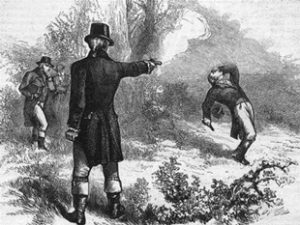
1806 – Revolutionary war veteran and future President Andrew Jackson killed attorney Charles Dickinson in a duel in Adairville, Kentucky. Jackson, a former senator and representative of Tennessee, called for the duel after his wife Rachel was slandered as a bigamist by Dickinson, who was referring to a legal error in the divorce from her first husband.
In accordance with dueling custom, the two stood 24 feet apart, with pistols pointed downward. Dickinson fired first, hitting Jackson in the chest. Under the rules of dueling, Dickinson had to remain still as Jackson took his one shot. Jackson’s shot hit Dickinson in the chest, fatally wounding his opponent.
Although he was the victor, Jackson paid a severe price. The bullet in Jackson was too close to his heart to operate, so Jackson carried it for the rest of his life, and suffered considerable pain from the wound.
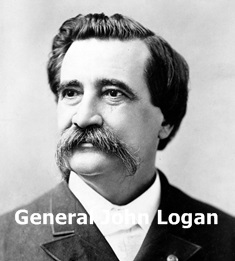
1868 – By proclamation of General John A. Logan of the Grand Army of the Republic, the first major Memorial Day observance was held to honor those who died “in defense of their country during the late rebellion.”
Known to some as “Decoration Day,” mourners honored the Civil War dead by decorating their graves with flowers. General James Garfield made a speech at Arlington National Cemetery, after which 5,000 participants helped to decorate the graves of the more than 20,000 soldiers (North and South) buried in the cemetery.
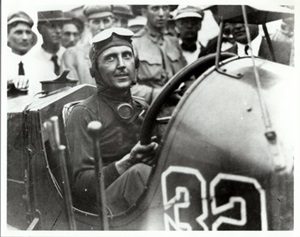
1911 – Ray Harroun drove his Marmon Wasp to victory in the inaugural Indianapolis 500. His time was considerably slower than modern Indy races. Harroun averaged a speed of 74.59 mph and a total time of 6 hours and 42 minutes.

1922 – Chief justice of the U.S. Supreme Court (and former President) William Howard Taft dedicated the Lincoln Memorial on the Washington Mall, and presented it to President Warren G. Harding, who accepted it on behalf of the American people. Lincoln’s only surviving son, 79-year-old Robert Todd Lincoln, was in attendance.
The centerpiece of the massive monument is a 170-ton, 19-foot seated figure of the 16th American president. The statue, carved under the supervision of the sculptor, Daniel Chester French, rises 30 feet from the floor.

1927 – The Kentucky River peaked during a massive flood that killed 89 people and left thousands homeless in Letcher County, KY. Torrential rains caused this unprecedented flood, which had a serious long-term impact on the communities of the region. Hundreds of men were out of work for months as the mines in which most worked had to be shut down.
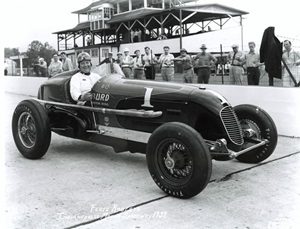
1939 – Shortly after posing for the photo above, defending Indianapolis 500 champion Floyd Roberts was killed when his Byrd Piston Ring Special, traveling at 100mph, went over an outer wall, through a fence and headfirst into a tree.
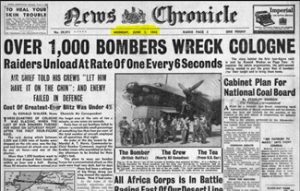
1942 – A thousand-plane raid on the German city of Cologne was launched by Great Britain. Almost 1,500 tons of bombs were dropped in 90 minutes, delivering a devastating blow to the Germans’ medieval city.
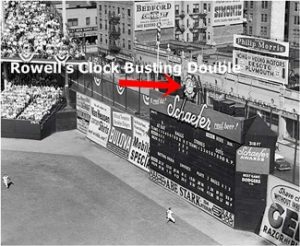
1946 – Carvel William “Bama” Rowell of the Boston Braves hit just 19 home runs in his career but the one he belted on this day shattered the Bulova Clock on top of the Ebbetts Field scoreboard.
Although Bulova promised a free watch to anyone who hit the clock, Rowell didn’t receive his watch until 41 years later.
Rowell’s long drive off the clock inspired the scene in Bernard Malamud’s 1952 novel The Natural, in which Roy Hobbs belts a home run off the light tower, resulting in glass pouring all over the diamond.
Unlike that famous scene, Rowell’s blast remained in play (even though it broke the clock) and Rowell ended up on second base with a double.

1955 – Two-time defending Indianapolis 500 champion Bill Vukovich was killed in a chain-reaction crash while holding a 17-second lead on the 57th lap.
Vukovich struck racer Johnny Boyd’s car, became airborne, and landed upside down after going over the outside backstretch retaining wall and somersaulting four-and-a-half times before hitting a low bridge near Turn 2 and bursting into flames.
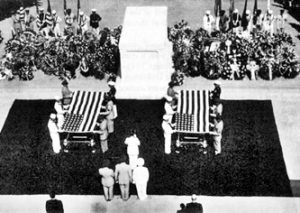
1958 – Thirty-seven years after the remains of an unknown soldier from World War I was laid to rest, the remains of two unidentified American servicemen, killed in action during World War II and the Korean War, respectively, were buried beside their World War I comrade at the Tomb of the Unknown Soldier in Arlington National Cemetery.

1971 – The U.S. unmanned space probe Mariner 9 was launched on a mission to gather scientific information on Mars. The 1,116-pound spacecraft entered the planet’s orbit nearly six months later and circled Mars twice each day for almost a year, photographing the surface and analyzing the atmosphere with infrared and ultraviolet instruments.
The first spacecraft to orbit another planet, Mariner 9 photographed 85% of Mars’ surface before depleting its supply of attitude control gas.
It was turned off on October 27, 1972 and remains a derelict satellite in Mars orbit. It is expected to remain in orbit until approximately 2022, when the spacecraft is projected to enter the Martian atmosphere and either burn up or crash into the planet’s surface.

1997 – In Trenton, NJ, child molester Jesse K. Timmendequas was found guilty – on charges of kidnapping, four counts of aggravated sexual assault, and two counts of felony murder – of raping and strangling a 7-year-old neighbor, Megan Kanka. The court sentenced him to death.
Timmendequas remained on New Jersey’s Death Row until December 17, 2007, when the New Jersey Legislature abolished the state’s death penalty. As a result of the ban, Timmendequas’ sentence was commuted to life in prison without the possibility of parole.
The murder led to the New Jersey State Legislature passing a statewide Megan’s Law, but the movement went well beyond that. On May 17, 1996, President Bill Clinton signed a national Megan’s Law as an amendment to the Jacob Wetterling Crimes Against Children’s Act. Megan’s Law requires each state in the country to notify the public when dangerous sexual offenders are residing in their area.
Each of the fifty states carries some form of public notification. Some states have developed a three-tiered system for categorizing the offenders by risk to the public.
Tier One, which is a low risk of reoffending.
Tier Two, which is a moderate risk of reoffending.
Tier Three, which is a high risk of reoffending. By using the three-tiered system, the state determines who in the public gets notified of the offender’s residence.
In some states, Tier Two notices go out to schools, day care centers and organizations who have children under their care. Tier Three notices go out to families living within a certain radius of the offender’s home.

2005 – Appearing on CNN’s Larry King Live, Vice President Dick Cheney predicted the Iraq war would end before the Bush administration left office, saying “The level of activity that we see today from a military standpoint, I think, will clearly decline. I think they’re in the last throes, if you will, of the insurgency.”
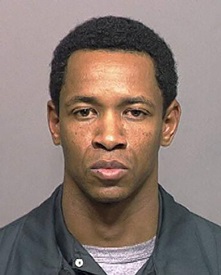
2006 – A Maryland jury found John Allen Muhammad guilty of six of the Washington-area “Beltway Sniper” killings. He had previously (2003) been convicted of the Virginia death of another man in connection with the shootings. Courts in both states sentenced him to death.
He died by lethal injection at the Greensville Correctional Center in Virginia on November 10, 2009.
Compiled by Ray Lemire ©2018 RayLemire.com. / Streamingoldies.com. All Rights Reserved.